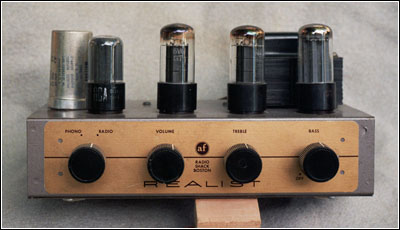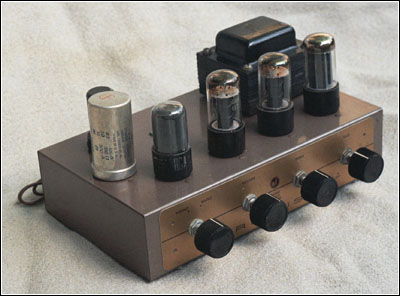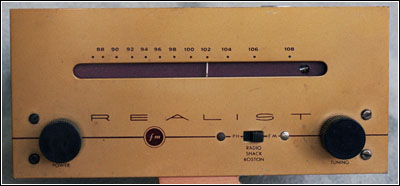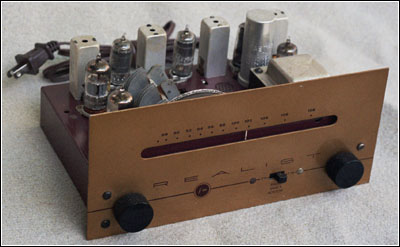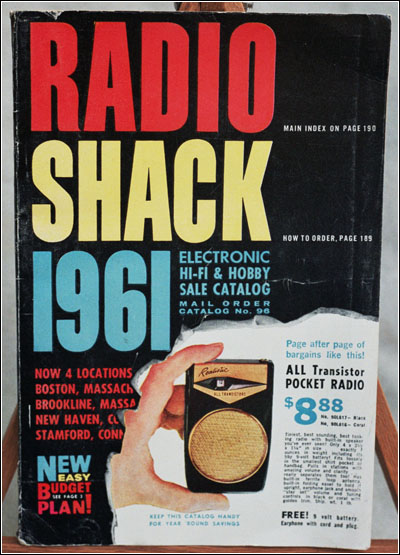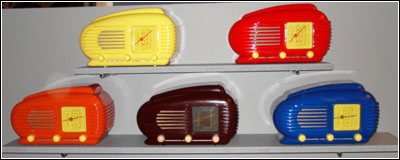Of Old Radios And Related Items--Published Monthly
Radio Shack
A Humble Beginning for an Electronics GiantBY ANDREW HAYDEN
WEB EDITION
Most of us don't think about how a company known as "RadioShack" today -- and "Radio Shack" in its earlier days -- came to be a giant retailer. Andrew Hayden traces the history of the company, a fixture in many neighborhoods throughout the country for decades -- a true American success story. (Editor)
Most things large start out small, and this holds true for the retailers of electronics and related items. However, few companies grew to be the corporate giant which RadioShack is today with its 7,000 retail stores nationwide, and operations in at least a dozen other counties. In 2003, RadioShack had net sales and operating revenues of $4.6 billion, making it the world's largest electronics retailer.
I doubt the Deutschmann brothers, Theodore and Milton, envisioned the kind of success that was to follow the opening of their "Radio Hut," as it was first called in 1921. In this one-store, retail, mail order operation in downtown Boston, they wanted to provide equipment for Amateur Radio enthusiasts. The store's name became "Radio Shack" early on, a name taken from the small structure or "radio shack" that then housed a ship's radio equipment.
Figure 1. A head-on view of the Radio Shack "Little Jewel" Model LJ-2 amplifier. Note the brand name "Realist" that preceded the better known "Realistic" line.The first Radio Shack catalog came out in the early 1940s. The company entered the growing high-fidelity market in 1947, opening the nation's first audio showroom where people could compare amps, speakers, and turntables.
It was 1954 when the recently formed Harman Kardon Company (HK) approached Radio Shack to see if it was interested in private label audio equipment. HK suggested the name "Realist" which Radio Shack accepted, and they began selling components with this name. The Realist Camera Company wasn't fond of Radio Shack's use of its name, and a lawsuit quickly followed. Radio Shack subsequently changed the "Realist" brand name to "Realistic." This famous name was to be used for the next 45 years until it was discontinued in 2000.
An interesting aside is that, in May of 2006, I sent an e-mail to RadioShack's Corporate Communications to let them know that they had some misinformation on their history page. The page said that the company had started selling the private brand "Realistic" in 1954, when, in fact, the name being used then was "Realist," which led to the lawsuit by the Realist Camera Company. RadioShack's online service manager thanked me and made the change. However, the photo of the Realist tuner which ignited the lawsuit is still being used!
Figure 2. Another view of the LJ-2 that shows its simplicity and clean design. The LJ-2 was manufactured by Grommes.Realist Amplifier and FM Tuner
Pictured in Figures 1-4 are a Realist monophonic amplifier and an FM tuner from 1954 when Radio Shack still had a single location. Each of these cute vintage hi-fi units is approximately 10" x 4" x 7". The amp, a "Little Jewel" LJ-2, was made by Grommes. Grommes was founded in 1946 and made some very nice amplifiers. Still in business today, the company is called Grommes-Precision, and it is one of the last American manufacturers of custom and consumer audio equipment.
Figure 3. A front panel view of the Radio Shack FM tuner. Again we see a unit that stresses simplicity and clean lines. Harman Kardon manufactured the FM tuner for Radio Shack and displays the "Realist" brand name.The tuner was made by Harman Kardon (HK), and sold for $39.95. HK was known for its innovation and quality. The front panels on both units are labeled "Realist Radio Shack Boston." The tube lineup is as follows: amplifier -- 5Y3, 6V6GT (2), 6SL7, 6SC7; tuner -- 6U8, 6AU6 (3), 6AL5, 12AT7. Both have a phono-tuner switch on their front panels.
High Fidelity's review of this tuner says, "With only six tubes, the designers are able to get sensitivity surprisingly close to that of tuners which sell for three or four times its cost." I have this pair hooked up to a 1963 KLH Model 14B loudspeaker, which has two 4-inch drivers, and I must say I'm impressed by the sound quality. This setup exemplifies the meaning of the phrase "less is more" -- a small hi-fi setup with great sound.
Figure 4. This view of the FM tuner shows a neat component layout and unadorned construction.From 1955 to the Present
Starting in 1955, Radio Shack began to have its private label products produced in Japan. Their literature claimed this was because Japan had numerous electronics factories located close to the source of component parts. However, as the rest of the U.S. audio industry found out in the coming years, it simply cost much less to produce in Japan.
By 1961, Radio Shack had expanded to four stores and the Realistic brand of products was proving to be successful. The company also carried many audio components by quality makers such as Dynaco, MacIntosh, and Jensen. The diversity and quantity of items offered in the 180-page catalog of 1961 is quite impressive. (See the catalog cover in Figure 5.) Nevertheless, Radio Shack was having serious financial troubles and was essentially broke.
In 1963, Charles Tandy bought the company for $300,000 and what followed was to be one of the greatest success stories of American retailing. Tandy had been running the Tandy Leather Company based in Fort Worth, Texas, with his father. They had 67 stores in 36 states.
After the purchase of Radio Shack, they eliminated everything, except electronics. Tandy was considered a driven marketing genius, and rapid growth followed. By 1969 there were 500 Radio Shack stores. Most of us have owned at least one piece of Realistic audio equipment from the 1970s. By this time, the company had firmly established a reputation for affordable, quality-made products. One of them was among the first personal computers offered to the public, the TRS-80, introduced in 1977. This limited function computer with its small black and white screen is in stark contrast to today's offerings.
Today the company is involved in every aspect of telecommunications and is the leading wireless retailer in the U.S. Since 2000, the name officially has been "RadioShack" (one word). The global environment for electronics is very competitive and seems to change frequently. Switching to an online catalog, RadioShack issued its last print catalog in 2002, marking the end of an era.
Some feel that the company has lost its way by seemingly focusing on cell phones and gadgets and moving away from the great audio products that were its bread and butter for so many years. In February 2006, RadioShack announced plans to close about 500 company-operated stores. Despite this, no matter what town you're in, it seems as though you are still able to find a RadioShack outlet within 20 minutes. This is something I'm sure the Deutschmann brothers could not have imagined when they opened their store in Boston 85 years ago. The company's impact on the electronics market in the 20th century was substantial, and only time will tell what the 21st century holds.
Figure 5. The cover of Radio Shack's 1961 catalog shows its four store locations, as well as a transistor pocket radio.References;
Farman, Irvin. Tandy's Money Machine. Chicago: The Mobium Press, 1992.
High Fidelity Magazine, April 1955.
RadioShack, www.radioshackcorporation.com/about/history.html.
Radio Shack Brochure, 1954.
Radio Shack Catalog, 1961.
(Andrew Hayden, 4 Barton Place, Newburyport, MA 01950. ash2222@verizon.net)
As his previous A.R.C. articles have indicated, Andrew Hayden is interested in the history of electronics companies. He has collected and researched vintage KLH electronics for over ten years.
Tesla Talisman 308U
BY GERALD FAASSEN
Web Edition
The Tesla Talisman 308U from the late 1950s was housed in colorful plastic cabinets. Though not shown in the print version of A.R.C., the colors of the sets above are shown here as follows: left to right, top, yellow and red; bottom, orange, brown, and blue. The cabinet design is said to have been inspired by the space ships in the British "Dan Dare" comic book series run in the Eagle magazine from 1950 to 1967. Licensed by Philips and manufactured in Czechoslovakia, the popular radio used four tubes and operated on 110 or 220 VAC.
(Gerald Faassen, Heldeweg 1, 5953TL Reuver, Holland)
| [Free Sample] [Books, etc., For Sale] [Subscribe to A.R.C./Renew] [Classified Ads] [Auction Prices] [Event Calendar] [Links] [Home] [Issue Archives] [Book Reviews] [Subscription Information] [A.R.C. FAQ] URL = http://www.antiqueradio.com/Feb07_RadioShack_Tesla.html Copyright © 1996-2007 by John V. Terrey - For personal use only. Last revised: December 26, 2006. For Customer Assistance please contact ARC@antiqueradio.com or call (866) 371-0512 toll free Pages designed/maintained by Wayward Fluffy Publications
Antique Radio Classified |
